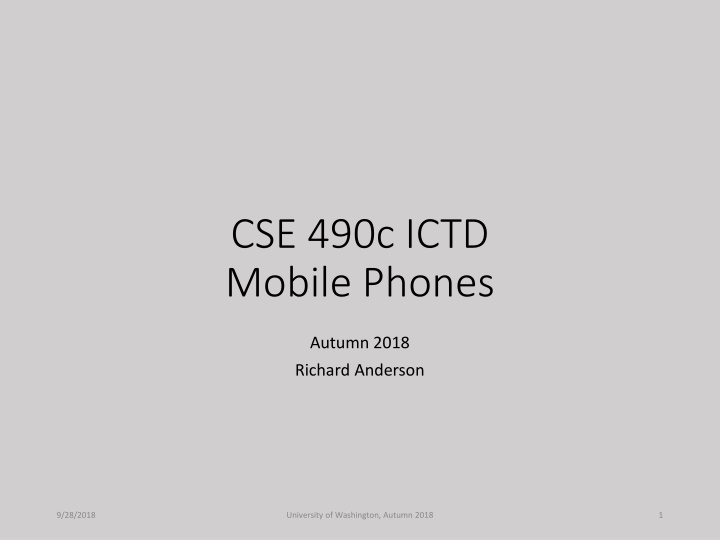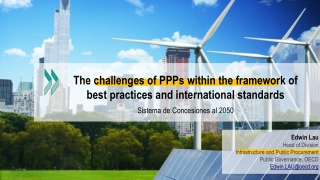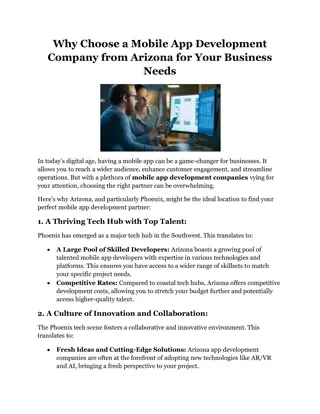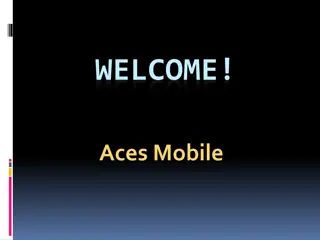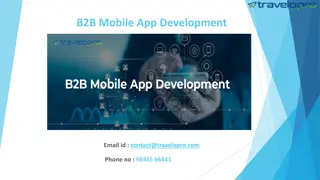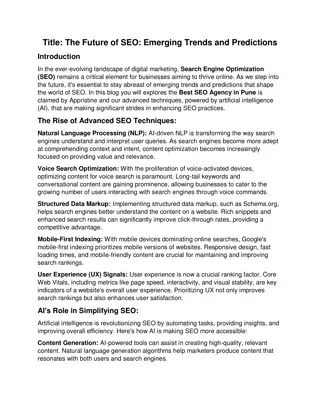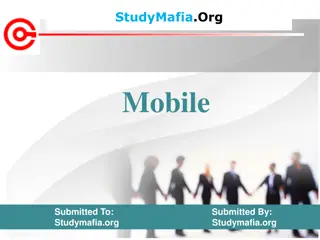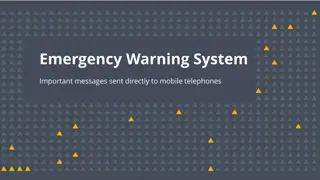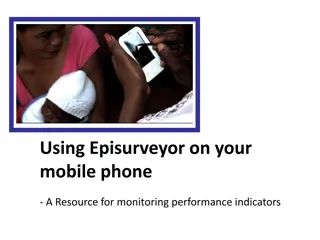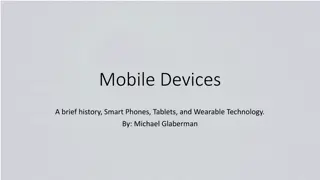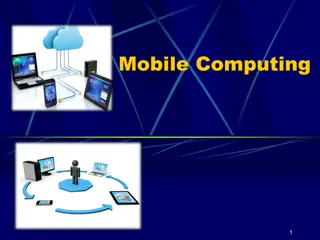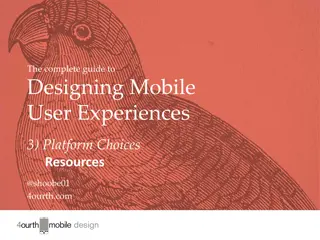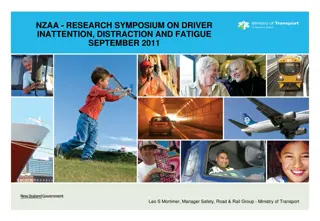The Impact of Mobile Phones on Development and Communication Infrastructure
Mobile phones have revolutionized communication globally, providing access to most adults. They have enabled communication in previously unreachable areas and transformed various industries. The adoption of mobile phones has been uneven across different groups. The evolution of handset types, from basic mobile phones to smartphones, showcases technological advancement. Cell phone timelines highlight the progression from analog to digital technologies like GSM, CDMA, and LTE, improving data speeds and internet connectivity.
Download Presentation

Please find below an Image/Link to download the presentation.
The content on the website is provided AS IS for your information and personal use only. It may not be sold, licensed, or shared on other websites without obtaining consent from the author.If you encounter any issues during the download, it is possible that the publisher has removed the file from their server.
You are allowed to download the files provided on this website for personal or commercial use, subject to the condition that they are used lawfully. All files are the property of their respective owners.
The content on the website is provided AS IS for your information and personal use only. It may not be sold, licensed, or shared on other websites without obtaining consent from the author.
E N D
Presentation Transcript
CSE 490c ICTD Mobile Phones Autumn 2018 Richard Anderson 9/28/2018 University of Washington, Autumn 2018 1
Administrative Course website https://courses.cs.washington.edu/courses/cse490c/18au/ Approximate grade weighting Homework 30 % Programming Assignments Technical 30 % Programming Assignments Writeup 30 % Participation 10 % Exams 0 % Homework 1 Due Wed Oct 3 Turn in PDF using canvas Programming Assignment 1 Due Oct 17 Will use Twilio. If you want to get started on it, set up a demo account and figure out how to send a message from a program to your phone, and from your phone to a program. 9/28/2018 University of Washington, Autumn 2018 2
Topic Overview Mobile Phones and Handsets Communication Infrastructure SMS Applications Voice Applications Mobile Money 9/28/2018 University of Washington, Autumn 2018 3
Mobile Phones and Development Mobile phones have had a dramatic impact worldwide Most adults have access to a mobile phone Leap frog technology did not replace land-lines Biggest impact is making communication possible where it wasn t previously Primarily commercially driven private or semi-private companies making oodles of money Mobile phones have transformed many activities and industries Adoption path across different groups has been uneven 9/28/2018 University of Washington, Autumn 2018 4
Handset Types Basic Mobile Phones Feature Phones Smart Phones 9/28/2018 University of Washington, Autumn 2018 5
Cell Phone timeline 1G: Analog Demonstration 1973. Commercial Launch: Japan 1979 (fully covered in 1984), Nordic countries 1981, USA 1983 2G: Digital GSM (Global System for Mobiles) Commercially launched in Finland in 1991. Mandated by European Union in 1987 In USA: ATT, T-Mobile Globally Dominant CDMA (Code Division Multiple Access) Commercially Introduced in USA in 1995. Dominated by Qualcomm. In USA: Sprint, Verizon, US Cellular. 2.5 G, 2.75 G: Enhanced Digital GPRS (General Packet Radio Service) Enhanced Data Rates for GSM Evolution (EDGE) 9/28/2018 University of Washington, Autumn 2018 6
Cell Phone timeline Marketing terms for multiple technologies 3G Faster data speeds Roll out: 2001 Japan, 2001 Isle of Man, 2003 USA Issue in release of new phones Different spectrum than 2G Widespread by 2007 4G Long Term Evolution (LTE) standard Even faster data speeds Internet Packet (IP) packet-switched technologies Introduced around 2009 / 2010 5G 2018-2020 Even faster data speeds 9/28/2018 University of Washington, Autumn 2018 7
Broadband Applications 9/28/2018 University of Washington, Autumn 2018 8
Cell Phone Worldwide Growth 2000 2001 2002 2003 2004 2005 2006 2007 2008 2009 2010 2011 2012 2013 2014 2015 2016 2017 Afghanistan 0 0 0 1 2 5 10 18 29 37 35 46 50 53 56 58 62 67 Australia 45 58 65 73 83 91 96 101 104 102 102 106 107 108 107 108 110 113 Canada 28 34 38 42 47 53 57 61 66 70 76 78 79 80 81 83 85 86 China 7 11 16 21 25 30 35 41 48 55 63 72 81 89 93 92 97 105 Germany 59 69 72 79 87 97 105 118 130 130 109 112 114 123 122 118 126 129 India 0 1 1 3 5 8 14 20 29 43 61 72 68 69 73 76 85 87 Kenya 0 2 4 5 7 13 20 30 42 48 60 66 70 71 73 80 80 86 Mali 0 0 0 2 3 6 11 19 24 31 49 70 91 120 139 130 112 Norway 72 79 83 89 98 103 104 107 109 111 115 116 116 112 112 110 109 108 Pakistan 0 1 1 2 3 8 22 39 54 56 58 63 68 70 73 66 71 73 Russian Federation 2 5 12 25 51 84 105 120 139 161 166 142 145 152 154 158 159 158 Rwanda 0 1 1 2 2 2 3 7 14 24 35 42 53 60 68 75 75 72 United Kingdom 74 78 83 91 100 109 115 120 121 122 121 121 122 122 121 121 120 120 United States 39 45 49 55 63 69 77 83 86 90 92 96 97 98 112 119 123 122 Uruguay 12 16 15 15 18 35 70 90 105 122 131 141 147 155 161 151 149 147 Venezuela 22 26 26 27 32 47 69 86 97 98 96 98 102 102 99 93 87 77 Viet Nam 1 2 2 3 6 11 22 52 86 112 126 142 146 135 147 129 128 126 Mobile Subscriptions per 100 inhabitants 9/28/2018 University of Washington, Autumn 2018 9
Cell phone subscriptions, 1985-2017 World South Asia Europe Sub-Saharan Africa 9/28/2018 University of Washington, Autumn 2018 10
Fish prices in Kerala Study by Robert Jensen of the wholesale price of fish at beach markets in Kerala, India Studied prices as cell towers were build moving up the coast 9/28/2018 University of Washington, Autumn 2018 11
Handset Constraints Connectivity Simcard Ownership Simcard Registration Airtime Balance Electrical charging Handset Cost 9/28/2018 University of Washington, Autumn 2018 12
Basic Mobile Phones (GSM Standard) Voice DTMF Dual Tone Multi-Frequency SMS Short Message Service USSD Unstructured Supplementary Service Data 9/28/2018 University of Washington, Autumn 2018 13
Voice + DTMF Analog signal for sound waves Converted by handset to digital data for transmission Multiple codecs can be used for conversion Voice Fundamental Frequency: Male (85 to 180 Hz), Female (165 to 255 Hz) Speaking frequency 20Hz to 20000 Hz Audible through 20000 Hz Telephony: Frequency band 300Hz to 3400 Hz. Sampling at 8000 Hz 9/28/2018 University of Washington, Autumn 2018 14
SMS (Short Messaging Service) Defined in 1985 as part of the GSM Standard Protocol allows seeing of up to 160 character alpha-numeric messages The hard thing in designing SMS was getting an agreed upon standard Deutsche Telekom + France Telecom The first SMS was sent over Vodafone GSM Network on December 3, 1992 in the UK Initial growth was very slow, significant growth around 2000 Designed for Engineers Took off when European Teenagers started using it SMS Gateway services are very important for building SMS applications more later Hack: You can send SMS from email 2065551212@tmomail.net 9/28/2018 University of Washington, Autumn 2018 15
Trivia What was the content of the first voice call? (Alexander Graham Bell to Thomas Watson, March 10, 1876) What was the content of the first text message? (Neil Papworth to Richard Jarvis, December 3, 1992) Why are SMS messages limited to 160 Characters. 9/28/2018 University of Washington, Autumn 2018 16
SMS Challenges Character limitation Expense Character Set restricted to basic Latin characters (7-bit characters) Unicode extensions require 16 bit greatly reducing message length Difficulty of entering letters on a keypad Reliability 9/28/2018 University of Washington, Autumn 2018 17
USSD Unstructured Supplementary Service Data Session based protocol for communicating by text between handset and service provider Initiated with a short code, e.g., *144# to check Safaricom balance 160 character strings sent back and forth between handset and provider until session is terminated Key differences from SMS Synchronized communication Direct with service provider: better security Does not leave messages on the phone Applications Adding services to cell service Mobile Money Yellow Pages Directory 9/28/2018 University of Washington, Autumn 2018 18
Universal Apps 9/28/2018 University of Washington, Autumn 2018 19
